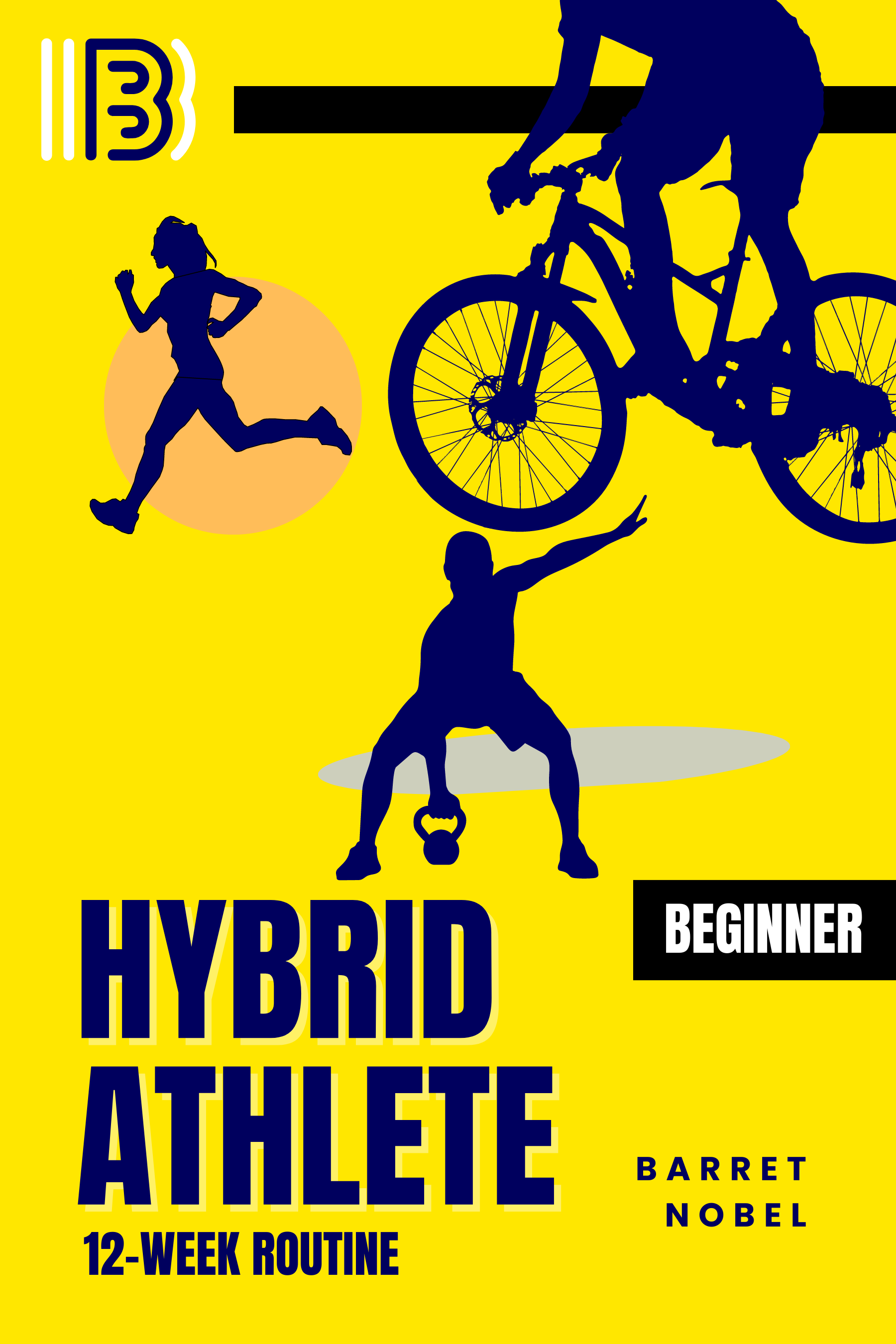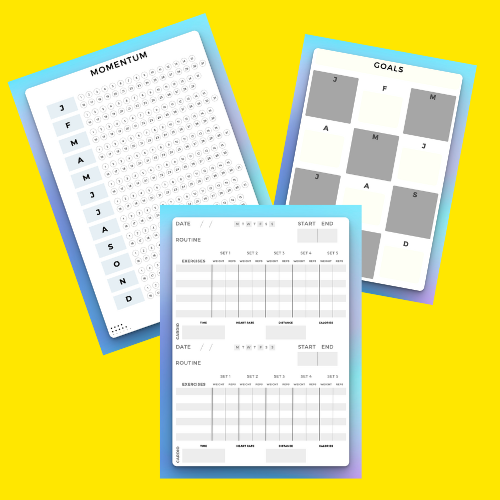Hybrid Athlete Training Plan
Learn how a hybrid athlete training plan can improve your overall athletic performance with a combination of strength, endurance, and flexibility.

A hybrid athlete is an individual who excels in multiple sports or disciplines, blending the best of strength, endurance, and skill-based training. Becoming a hybrid athlete requires a unique approach to training, one that combines various methods to maximize your potential. In this article, we will discuss the benefits of hybrid athlete training and provide a comprehensive guide to designing a training plan tailored to your needs.
Explore some of the sponsors of this blog and discover cool apps, products, or websites that I'm currently using and loving by visiting the links below 👇
Do Hard Things*: Achieve fitness goals with Fit for Life, a minimalist log book for men and women. Track progress and set monthly goals with expert design.
LMNT: Stay Salty! A tasty electrolyte drink mix that is formulated to help anyone with their electrolyte needs and is perfectly suited to folks fasting or following low-carb, whole-food diets
Nurecover: Leaders in cold therapy. A simple effective way to enjoy cold water therapy LITERALLY anywhere from your; House, Patio, Garden, Balcony, Work, Holiday, Apartment.
yourcompany.com: Interested in sponsoring this blog? 📩 → blogSponsor@hybridathletepro.com
Benefits of Hybrid Athlete Training
There are several benefits to becoming a hybrid athlete. These include:
- Increased overall athleticism: By training in various disciplines, you can develop a well-rounded skill set that translates to improved performance in multiple sports.
- Enhanced injury prevention: A diverse training regimen can help reduce the risk of injury by balancing muscle development and addressing imbalances in strength and flexibility.
- Improved mental fortitude: Tackling multiple training modalities challenges your mental resilience, helping you develop the mental toughness needed to excel in any athletic endeavor.
- Greater adaptability: Hybrid athletes can more easily transition between sports or activities, making them versatile and valuable team members.
Designing a Hybrid Athlete Training Plan

Hybrid Athlete 12-Week Routine | Beginner
Curious what all this hybrid athlete hype is about? This book provides a 12-week workout routine, but also information on the importance of being a well-rounded athlete. By incorporating a balance of strength and endurance into your training, you'll be able to reduce your risk of injury, improve your overall health, and reach your goals!
Identify Your Goals
When identifying your goals as a hybrid athlete, consider both short-term and long-term objectives. Short-term goals may include improving specific skills, increasing strength or endurance, or participating in a particular event. Long-term goals could involve achieving a certain level of performance in multiple sports or maintaining a high level of overall fitness for years to come.
To create meaningful and achievable goals, use the SMART criteria:
- Specific: Clearly define what you want to achieve. Instead of "I want to get stronger," opt for "I want to increase my deadlift by 50 pounds."
- Measurable: Make sure your goals are quantifiable. Tracking your progress will be easier if you can measure improvements.
- Attainable: Set goals that are challenging but achievable. Unrealistic expectations can lead to disappointment and decreased motivation.
- Relevant: Ensure your goals align with your overall objectives as a hybrid athlete. Focus on what will truly help you excel in your chosen disciplines.
- Time-bound: Establish a timeline for achieving your goals. Deadlines create a sense of urgency and encourage consistent effort.
Once you have established your goals, you can use them to inform the rest of your hybrid athlete training plan. For instance, if one of your goals is to improve your endurance for a specific event, you can prioritize endurance training and incorporate specific workouts geared toward that objective. By keeping your goals in mind throughout your training, you'll be more likely to stay focused and committed to your plan.

Assess Your Current Fitness Level
Assessing your current fitness level is crucial in determining the starting point of your hybrid athlete training journey. It helps you establish a baseline from which you can measure your progress and set realistic goals. To effectively assess your fitness level, consider the following steps:
Test Your Strength
To gauge your strength, perform basic strength exercises like push-ups, pull-ups, squats, and deadlifts. Track the number of repetitions you can complete with proper form or the maximum weight you can lift for one repetition (1RM). These numbers will serve as a benchmark for monitoring your progress in strength training.
Evaluate Your Endurance
Cardiovascular endurance can be assessed through various tests, such as timed runs or rows, or measuring your VO2 max. For a simple test, time yourself while running or jogging a specific distance, like one mile or 5 kilometers. You can then use this baseline to track improvements in your cardiovascular fitness.
Measure Your Flexibility
Flexibility is an essential aspect of overall fitness, particularly for injury prevention and functional movement. To assess your flexibility, perform stretches that target major muscle groups, such as hamstring stretches, shoulder stretches, and hip flexor stretches. Take note of your range of motion and any discomfort or limitations during these stretches, which can guide your focus on improving flexibility in your training plan.
Determine Your Skill Level
Depending on your chosen sports or disciplines, you may need to evaluate your skill level in specific areas. For example, if you're training for martial arts, assess your proficiency in various techniques or sparring. Similarly, if you're aiming to excel in a particular sport, evaluate your ability in sport-specific skills such as dribbling, shooting, or passing.
Track Your Body Composition
While not the sole indicator of fitness, tracking your body composition can provide valuable insights into your overall health and progress. Measure your body fat percentage, lean muscle mass, and weight to establish a baseline from which you can monitor changes throughout your training program.
By thoroughly assessing your current fitness level, you'll gain a better understanding of your strengths and weaknesses. This information will help you design a well-balanced hybrid athlete training plan that targets areas needing improvement and sets the foundation for long-term success. Periodically reassess your fitness level to track your progress and adjust your training plan accordingly.
Choose the Right Mix of Training Modalities
Choosing the right mix of training modalities is essential for creating an effective hybrid athlete training plan. The right blend of activities will help you develop a well-rounded skill set, improve your overall athleticism, and minimize the risk of injury.
Ensure that the training modalities you choose align with your specific goals as a hybrid athlete. For example, if you aim to excel in a sport that demands a high level of strength and power, prioritize strength training in your regimen. Conversely, if you're working towards a long-distance running event, focus on endurance training.
To achieve a well-balanced training plan, incorporate various training techniques that address different aspects of fitness. This can include a mix of resistance training, bodyweight exercises, plyometrics, and functional movements to improve strength and power. Additionally, vary your endurance training with a combination of steady-state cardio, interval training, and sport-specific conditioning.
When selecting training modalities, take into account the specific demands of the sports or disciplines you're targeting. For example, if you're training for a sport that requires explosive power, such as basketball or sprinting, include plyometric exercises in your program. Similarly, if your goals involve a sport with unique skill requirements, such as gymnastics or rock climbing, incorporate drills and exercises that develop those specific abilities.
Balance Intensity and Recovery
A well-rounded hybrid athlete training plan should strike a balance between high-intensity workouts and recovery sessions. Incorporate active recovery techniques, such as light cardio or mobility exercises, on days following intense training sessions. This balance will help minimize the risk of overtraining, promote recovery, and optimize your performance.
To prevent plateaus and maintain progress, rotate your training modalities regularly. For instance, you might focus on strength training for a few weeks, followed by a period of endurance training. This rotation can help keep your workouts fresh and engaging while continually challenging your body to adapt and improve.
By carefully selecting and blending various training modalities, you can create a hybrid athlete training plan that supports your unique goals and needs. Continually evaluate your progress and adjust your training modalities as necessary to ensure you're on track to achieve your objectives and unlock your full potential as a hybrid athlete.

Schedule Your Training
Scheduling your training effectively is crucial for maximizing your progress as a hybrid athlete. A well-structured schedule helps you balance different training modalities, manage workout intensity, and prioritize recovery. Keep the following tips in mind when scheduling your hybrid athlete training plan:
Determine Your Training Frequency
First, determine how many days per week you'll train. This decision will depend on your goals, current fitness level, and available time. For most hybrid athletes, training 4-6 days per week is an ideal frequency, allowing enough time for recovery while still maintaining consistent progress.
Allocate Training Modalities
Next, allocate your chosen training modalities throughout the week. For example, you may decide to dedicate two days to strength training, two days to endurance training, and one day to skill-specific work. Be mindful of balancing different modalities to prevent overtraining in any single area and ensure a well-rounded approach.
Plan the intensity and volume of your workouts to avoid overloading your body and allow for adequate recovery. For instance, schedule high-intensity workouts, such as heavy strength training or intense interval sessions, on non-consecutive days. On the days in between, focus on lower-intensity activities, like steady-state cardio, mobility work, or skill-specific training.
Incorporate Rest and Recovery Days
Don't forget to schedule rest days and active recovery sessions within your training plan. Rest days allow your body to recover and repair, preventing overtraining and reducing the risk of injury. Active recovery sessions, such as light cardio, yoga, or mobility exercises, help promote circulation and aid in muscle recovery while still keeping you active.
Finally, be prepared to adjust your training schedule as needed based on your progress, performance, and feedback from your body. You may find that you need to increase or decrease the frequency of certain training modalities, adjust the intensity of your workouts, or modify your rest days. Continually assess and adapt your schedule to optimize your hybrid athlete training plan.
By carefully scheduling your training, you can create a balanced and effective hybrid athlete training plan that supports your goals and promotes consistent progress. Remember, the key to success lies in finding the right balance between training modalities, workout intensity, and recovery to help you unlock your full potential as a hybrid athlete.
Monitor Your Progress and Adjust
Monitoring your progress and making adjustments to your hybrid athlete training plan is essential for continued improvement and achieving your goals. Regularly tracking your performance, assessing your strengths and weaknesses, and adapting your training approach will ensure that you stay on track and make the most of your efforts.
Keep a detailed log of your workouts, including the exercises performed, sets, repetitions, weights used, and any personal records achieved. This data will help you identify trends in your performance, recognize areas needing improvement, and make informed decisions about adjustments to your training plan.

Fit for Life | Workout Tracker
Take control of your fitness journey with Fit for Life, the expert-designed minimalist fitness log book for men and women. This comprehensive log book is the perfect companion for your workouts, helping you to track progress, set and achieve monthly goals, and monitor momentum.
Reassess Your Fitness Level
Periodically reassess your fitness level using the same methods you employed at the beginning of your training journey. By comparing your current performance to your initial baseline, you can measure your progress and determine whether your training plan is effectively addressing your goals and needs.
Set Short-Term and Long-Term Goals
Establish both short-term and long-term goals to guide your training and provide motivation. Short-term goals can include achieving a specific personal record, mastering a new skill, or completing a particular event. Long-term goals might involve reaching an elite level of performance in a chosen sport or discipline or maintaining a high level of overall fitness for years to come. Regularly review and adjust your goals as needed to ensure they remain challenging and relevant.
Pay close attention to how your body responds to your training plan. If you notice signs of overtraining, such as excessive fatigue, decreased performance, or persistent soreness, consider adjusting your workout intensity or incorporating additional rest days. Similarly, if you find that you're consistently feeling strong and energetic, you may be ready to increase the intensity or volume of your training.
Seek Feedback and Support
Consider seeking feedback and support from coaches, trainers, or fellow hybrid athletes. They can provide valuable insights into your performance, technique, and overall progress. Additionally, surrounding yourself with like-minded individuals can offer motivation, camaraderie, and accountability.
By regularly monitoring your progress and making adjustments to your training plan, you can optimize your hybrid athlete training approach and maximize your potential. Remember that progress may not always be linear, and setbacks are a normal part of the journey. Stay committed, adaptable, and focused on your goals, and you'll continue to grow and excel as a hybrid athlete.
Nutrition for Hybrid Athletes
Nutrition plays a vital role in supporting the demands of a hybrid athlete training plan. A well-rounded and balanced diet provides the necessary energy, macronutrients, and micronutrients to fuel your workouts, promote recovery, and optimize performance. There are entire in-depth articles about this topic here -> https://www.hybridathletepro.com/the-ultimate-hybrid-athlete-nutrition-plan-for-optimal-performance and here -> https://www.hybridathletepro.com/the-best-foods-to-fuel-your-hybrid-athlete-training
Caloric Intake
Determine your daily caloric needs based on your age, weight, activity level, and goals. If you aim to build muscle or gain weight, you'll need to consume more calories than you burn. Conversely, if your goal is to lose weight or reduce body fat, create a caloric deficit by consuming fewer calories than you expend. Monitor your weight and body composition regularly to ensure you're meeting your nutritional needs and adjust your caloric intake as needed.
Macronutrient Balance
Macronutrients, including carbohydrates, proteins, and fats, are essential for energy, growth, and recovery. As a hybrid athlete, you'll need a balanced intake of all three macronutrients to support your diverse training needs. A general guideline for macronutrient distribution is:
- Carbohydrates: 45-65% of total daily calories
- Proteins: 10-35% of total daily calories
- Fats: 20-35% of total daily calories
These ratios can be adjusted based on individual preferences and specific training goals.
Carbohydrates are the body's primary source of energy, particularly for high-intensity workouts and endurance training. Focus on consuming complex carbohydrates, such as whole grains, fruits, and vegetables, which provide a steady supply of energy and essential nutrients.
Protein is crucial for muscle growth, repair, and recovery following your workouts. Aim to consume a variety of high-quality protein sources, including lean meats, fish, dairy products, eggs, legumes, and plant-based protein options.
Incorporate healthy fats into your diet, such as avocados, nuts, seeds, and olive oil, to support hormone production, maintain energy levels, and promote overall health. Avoid excessive consumption of saturated and trans fats, which can negatively impact cardiovascular health and performance.
Micronutrients for Optimal Health
In addition to macronutrients, ensure you're consuming an adequate intake of vitamins and minerals through a diverse diet rich in fruits, vegetables, whole grains, lean proteins, and healthy fats. Micronutrients play a crucial role in supporting immune function, energy metabolism, and overall health.
Hydration
Proper hydration is essential for optimal performance and recovery. Aim to consume at least 8-10 cups of water per day, with additional fluid intake during and after exercise to replace sweat losses. Electrolyte replacement beverages can be beneficial during long or intense workouts to maintain hydration and electrolyte balance.
By prioritizing your nutrition as a hybrid athlete, you'll provide your body with the essential nutrients it needs to excel in your diverse training program. Remember that individual needs can vary, so continually monitor your progress, energy levels, and overall well-being, and adjust your nutrition plan accordingly to best support your goals and performance.
Recovery Strategies
Recovery strategies are a critical component of a successful hybrid athlete training plan. Adequate recovery allows your body to repair and rebuild after intense workouts, promoting adaptation and minimizing the risk of injury or overtraining.
Prioritize Sleep
Sleep is essential for both physical and mental recovery. Aim for 7-9 hours of quality sleep each night to promote muscle repair, immune function, and hormonal balance. Establish a consistent sleep schedule, create a relaxing bedtime routine, and minimize exposure to screens and stimulants before bed to improve sleep quality.
Incorporate Active Recovery
Active recovery involves low-intensity, low-impact exercises that promote blood flow and help flush out waste products from your muscles. On your rest days or after intense workouts, engage in activities such as light cycling, walking, or swimming to aid in muscle recovery and maintain mobility.
Regular stretching and mobility exercises can help maintain and improve flexibility, reduce muscle soreness, and prevent injury. Incorporate dynamic stretching before your workouts to warm up your muscles and static stretching after your workouts to promote relaxation and flexibility.
Utilize Foam Rolling and Self-Myofascial Release
Foam rolling and self-myofascial release techniques can help alleviate muscle tightness, reduce soreness, and improve range of motion. Regularly use a foam roller or massage tools to target tight or sore areas and improve muscle tissue quality.
As mentioned earlier, proper nutrition and hydration play a crucial role in recovery. Ensure you're consuming an adequate amount of carbohydrates, proteins, and fats to support muscle repair, replenish glycogen stores, and maintain hormonal balance. Additionally, prioritize hydration to prevent cramping, fatigue, and impaired performance.
Manage Stress
Stress management is an essential aspect of recovery, as chronic stress can hinder your body's ability to repair and recover. Incorporate stress-reducing practices into your daily routine, such as meditation, deep breathing exercises, or engaging in hobbies and activities you enjoy.
Pay close attention to how your body feels and responds to your training and recovery practices. If you're experiencing excessive fatigue, persistent soreness, or a decline in performance, consider adjusting your training schedule, intensity, or recovery strategies to better support your body's needs.
By prioritizing recovery strategies in your hybrid athlete training plan, you'll optimize your body's ability to repair, adapt, and grow, ensuring that you continue to progress towards your goals. Recovery is just as important as the workouts themselves, and finding the right balance between training and rest is essential for long-term success.
Common Mistakes to Avoid
Avoiding common mistakes in your hybrid athlete training plan can help you stay on track, prevent injuries, and maximize your progress. Keep these pitfalls in mind as you develop and implement your training strategy:
1. Neglecting Recovery
As discussed earlier, recovery is a critical component of any successful training plan. Neglecting proper recovery practices, such as sleep, active rest, stretching, and nutrition, can hinder your progress and increase the risk of injury or overtraining.
2. Overemphasizing One Training Modality
Focusing too heavily on one training modality at the expense of others can lead to imbalances and limit your overall potential as a hybrid athlete. Strive for a well-rounded approach that incorporates strength, endurance, skill-specific training, and other components relevant to your goals.
3. Insufficient Periodization
Periodization involves systematically varying the intensity, volume, and focus of your training over time to promote adaptation and prevent plateaus. Failing to incorporate periodization into your plan can lead to stagnation and a lack of progress. Periodically reassess and adjust your training plan to ensure continued growth and improvement.
4. Ignoring Technique and Form
Proper technique and form are essential for preventing injuries and maximizing the effectiveness of your workouts. Invest time in learning and refining your technique, and avoid the temptation to prioritize heavy loads or faster times over proper form.
5. Setting Unrealistic Goals
Setting unrealistic goals can lead to frustration, burnout, and a loss of motivation. Establish short-term and long-term goals that are challenging yet achievable, and continually reassess and adjust your goals as needed to ensure they remain relevant and attainable.
6. Not Tracking Progress
Regularly monitoring your progress is crucial for identifying trends, assessing the effectiveness of your training plan, and making informed adjustments. Failing to track your workouts, performance metrics, and other relevant data can leave you in the dark about your progress and limit your ability to optimize your training approach.

Fit for Life | Workout Tracker
Take control of your fitness journey with Fit for Life, the expert-designed minimalist fitness log book for men and women. This comprehensive log book is the perfect companion for your workouts, helping you to track progress, set and achieve monthly goals, and monitor momentum.
7. Not Listening to Your Body
Ignoring the signals your body sends can result in overtraining, injury, or burnout. Pay close attention to how your body feels and responds to your training and recovery practices, and be prepared to adjust your approach as needed to support your overall well-being and performance.
By being aware of and avoiding these common mistakes, you can create a more effective and sustainable hybrid athlete training plan that supports your goals and promotes consistent progress.
FAQs
What is a hybrid athlete?
A hybrid athlete is an individual who excels in multiple sports or disciplines, blending strength, endurance, and skill-based training.
How do I become a hybrid athlete?
To become a hybrid athlete, create a tailored training plan that incorporates various training modalities, such as strength, endurance, and skill-specific training. Additionally, focus on proper nutrition and recovery strategies.
How often should I train as a hybrid athlete?
The frequency of your training sessions will depend on your goals and current fitness level. However, a balanced approach typically involves training 4-6 days per week, with scheduled rest days for recovery.
Can I become a hybrid athlete if I only have access to a home gym?
Yes, you can still become a hybrid athlete with limited equipment. Focus on bodyweight exercises, calisthenics, and functional movements that can be performed with minimal equipment. Investing in versatile equipment like resistance bands, kettlebells, and a jump rope can also help you create an effective hybrid training program at home.
How long does it take to see results from a hybrid athlete training plan?
The time it takes to see results will vary depending on your individual goals, starting fitness level, and consistency in training. However, most people can expect to see noticeable improvements in their performance and physique within 8-12 weeks of following a well-structured hybrid athlete training plan. Keep in mind that progress may be slower at first, but consistency and dedication are key to long-term success.
If you're a regular ol' hybrid athlete, you might fall in love with my Tubes channel 👇
https://www.youtube.com/@BarretNobelFitness
It is not only about fitness, it is about life in general. I try to inspire regular people. Check it and subscribe to get notified when new vids come out 🤙
Thanks for reading 🙏!
Don't forget to follow me on our social media for more tips, inspiration and community support! You can find me on Instagram, Facebook, Twitter and TikTok under the handle @BarretNobelFit.
See you in the next post!


